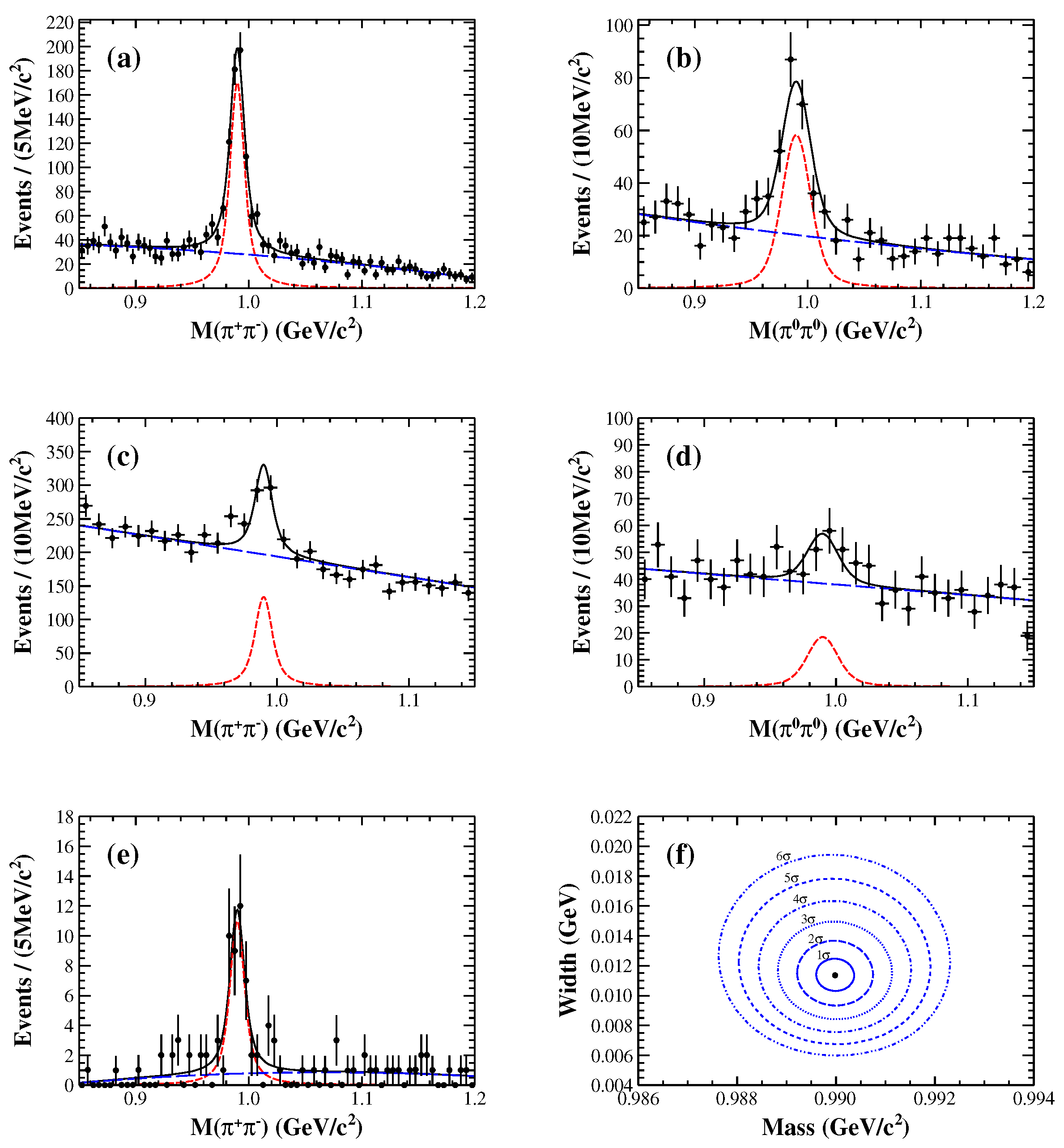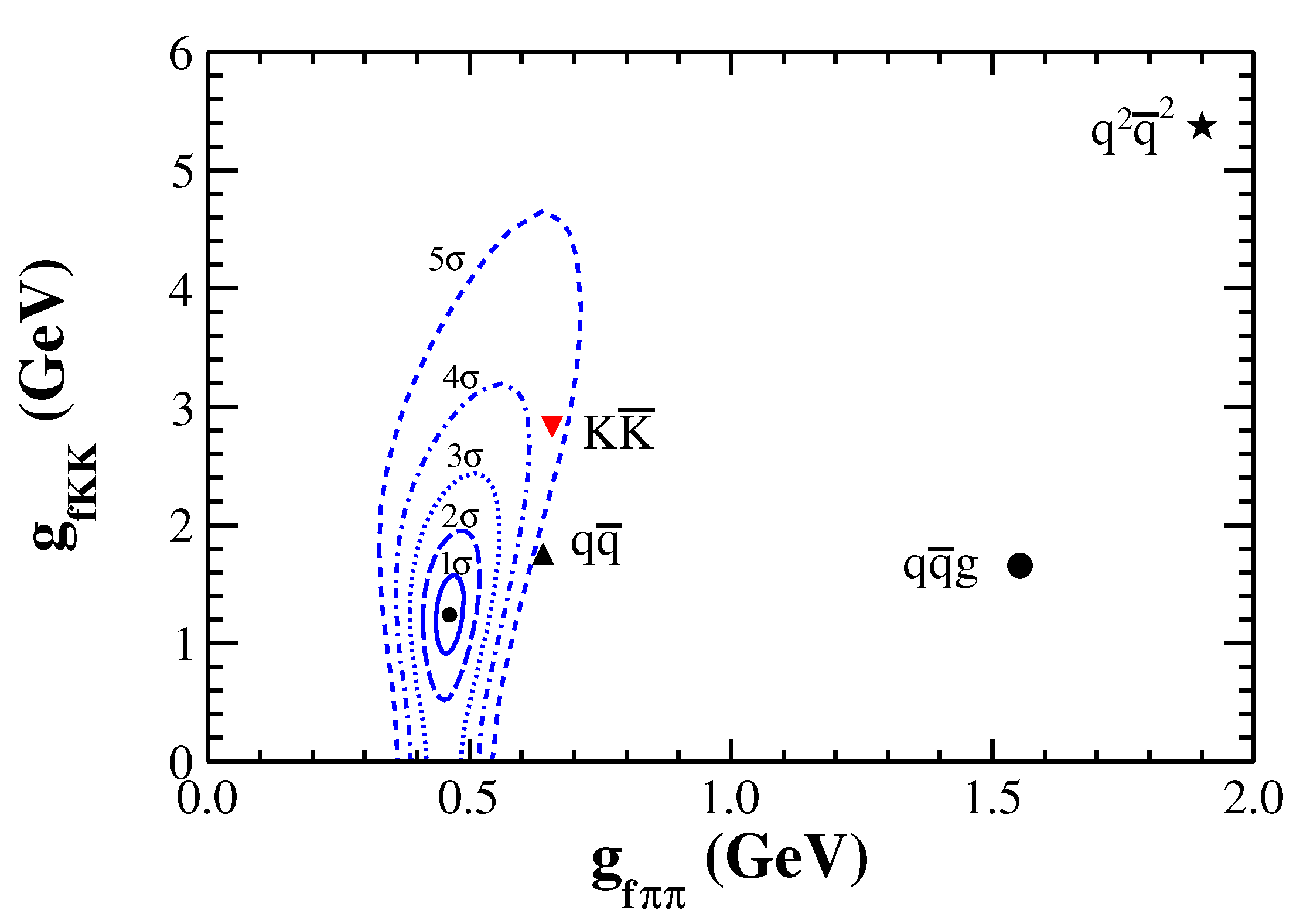Submitted:
14 May 2023
Posted:
15 May 2023
You are already at the latest version
Abstract
Keywords:
1. Introduction
2. Simultaneous fit to invariant mass distributions in isospin-violating decays
3. Determination of coupling constants of and
4. Joint confidence regions of the coupling constants and
5. Summary
Author Contributions
Funding
Institutional Review Board Statement
Informed Consent Statement
Data Availability Statement
Acknowledgments
Conflicts of Interest
Abbreviations
| PDG | Particle Data Group |
| BESIII | Beijing Spectrometer III |
References
- R. L. Workman et al. (Particle Data Group). Review of Particle Physics. Prog. Theor. Exp. Phys. 2022, 2022, 083C01.
- M.N. Achasov et al. (SND Collaboration). The ϕ(1020)→π0π0γ decay. Phys. Lett. B 2000, 485, 349–356.
- A. Aloisio et al. (KLOE Collaboration). Study of the decay ϕ→π0π0γ with the KLOE detector. Phys. Lett. B 2002, 537, 21–27. [CrossRef]
- M. Ablikim et al. (BESIII Collaboration). Resonances in J/ψ→ϕπ+π− and ϕK+K−. Phys. Lett. B 2005, 607, 243–253.
- B. Aubert et al. (BABAR Collaboration). e+e−→K+K−π+π−, K+K−π0π0 and K+K−K+K− cross sections measured with initial-state radiation. Phys. Rev. D 2007, 76, 012008. [CrossRef]
- R. García-Martín, R. Kamiński, J. R. Peláez, J. Ruiz de Elvira and F. J. Ynduráin. Pion-pion scattering amplitude. IV. Improved analysis with once subtracted Roy-like equations up to 1100 MeV. Phys. Rev. D 2011, 83, 074004.
- R. García-Martín, R. Kamiński, J. R. Peláez, and J. Ruiz de Elvira. Precise Determination of the f0(600) and f0(980) Pole Parameters from a Dispersive Data Analysis. Phys. Rev. Lett. 2011, 107, 072001. [CrossRef]
- K.A. Olive et al. (Particle Data Group). Review of Particle Physics. Chin. Phys. C 2014, 38, 090001.
- M.Ablikim et al. (BESIII Collaboration). First Observation of η(1405) Decays into f0(980)π0. Phys. Rev. Lett. 2012, 108, 182001. [CrossRef]
- M. Ablikim et al. (BESIII Collaboration). Observation of the isospin-violating decay J/ψ→ϕπ0f0(980). Phys. Rev. D 2015, 92, 012007. [CrossRef]
- M. Ablikim et al. (BESIII Collaboration). Observation of (980)−f0(980) Mixing. Phys. Rev. Lett. 2018, 121, 022001. [CrossRef]
- J. Weinstein and N. Isgur qq qq system in a potential model. Phys. Rev. D 2015, 27, 588.
- J. Weinstein and N. Isgur KK molecules. Phys. Rev. D 1990, 41, 2236. [CrossRef]
- S. Ishida et al., In Proceedings of the 6th International Conference on Hadron Spectroscopy, Manchester, United Kingdom, 10th-14th July 1995 (World Scientific, Singapore, 1995), p.454.
- N. N. Achasov, S. A. Devyanin, and G. N. Shestakov S*-δ0 mixing as a threshold phenomenon. Phys. Lett. B 1979, 88, 367–371. [CrossRef]
- B. Kerbikov and F. Tabakin. Mixing of the f0 and a0 scalar mesons in threshold photoproduction. Phys. Rev. C 2000, 62, 064601. [CrossRef]
- N. N. Achasov and G. N. Shestakov. Proposed Search for (980)−f0(980) Mixing in Polarization Phenomena. Phys. Rev. Lett. 2004, 92, 182001. [CrossRef]
- N.N. Achasov and G. N. Shestakov. Manifestation of the (980)-f0(980) mixing in the reaction π-p→ηπ0n on a polarized target. Phys. Rev. D 2004, 70, 074015. [CrossRef]
- A. E. Kudryavtsev and V. E. Tarasov. On the possibility of observation of a0-f0 mixing in the pn→da0 reaction. JETP Lett. 2000, 72, 410. [CrossRef]
- A.E. Kudryavtsev, V. E. Tarasov, J. Haidenbauer, C. Hanhart, and J. Speth. Angular asymmetries in the reactions p→dπ+η and n→dπ0η and a0-f0 mixing. Phys. At. Nucl. 2003, 66, 1946.
- A. E. Kudryavtsev, V. E. Tarasov, J. Haidenbauer, C. Hanhart, and J. Speth. Aspects of a0-f0 mixing in the reaction da0. Phys. Rev. C 2002, 66, 015207. [CrossRef]
- V.Y. Grishina, L. A. Kondratyuk, M. Büscher, W. Cassing, and H. Ströher. a0(980)-f0(980) mixing and isospin violation in the reactions pN→da0, pd→3He/3Ha0 and dd→4Hea0. Phys. Lett. B 2001, 521, 217–224. [CrossRef]
- F.E. Close and A. Kirk. Isospin breaking exposed in f0(980)-a0(980) mixing. Phys. Lett. B 2000, 489, 24–28. [CrossRef]
- F.E. Close and A. Kirk. Large isospin mixing in ϕ radiative decay and the spatial size of the f0(980)-a0(980) mesons. Phys. Lett. B 2001, 515, 13–16. [CrossRef]
- C.Hanhart, B. Kubis, and J. R. Pelaez. Investigation of a0–f0 mixing. Phys. Rev. D 2007, 76, 074028. [CrossRef]
- J.J. Wu, Q. Zhao and B. S. Zou. Possibility of measuring (980)−f0(980) mixing from J/ψ→ϕ(980). Phys. Rev. D 2007, 75, 114012. [CrossRef]
- J.J. Wu and B. S. Zou. Study of (980)−f0(980) mixing from (980)→f0(980) transition. Phys. Rev. D 2008, 78, 074017. [CrossRef]
- M.Ablikim et al. (BESIII Collaboration). Study of (980)-f0(980) mixing. Phys. Rev. D 2011, 83, 032003.
- J.-J. Wu, X.-H. Liu, Q. Zhao and B.-S. Zou. Puzzle of Anomalously Large Isospin Violations in η(1405/1475)→3π. Phys. Rev. Lett. 2012, 108, 081803. [CrossRef]
- F. Aceti, W. H. Liang, E. Oset, J. J. Wu and B. S. Zou. Isospin breaking and f0(980)-a0(980) mixing in the η(1405)→π0f0(980) reaction. Phys. Rev. D 2012, 86, 114007. [CrossRef]
- Meng-Chuan Du and Qiang Zhao. Internal particle width effects on the triangle singularity mechanism in the study of the η(1405) and η(1475) puzzle. Phys. Rev. D 2019, 100, 036005. [CrossRef]
- Meng-Chuan Du, Yin Cheng, and Qiang Zhao. Vertex corrections due to the triangle singularity mechanism in the light axial vector meson couplings to K*K+c.c. Phys. Rev. D 2022, 106, 054019. [Google Scholar] [CrossRef]
- En Wang, Ju-Jun Xie, Wei-Hong Liang, Feng-Kun Guo, and Eulogio Oset. Role of a triangle singularity in the γp→K+Λ(1405) reaction. Phys. Rev. C 2017, 95, 015205. [Google Scholar] [CrossRef]
- Hao-Jie Jing, Shuntaro Sakai, Feng-Kun Guo and Bing-Song Zou. Triangle singularities in J/ψ→ηπ0ϕ and π0π0ϕ. Phys. Rev. D 2019, 100, 114010. [Google Scholar] [CrossRef]
- Shuntaro Sakai, Eulogio Oset, and Feng-Kun Guo. Triangle singularity in the B-→K-π0X(3872) reaction and sensitivity to the X(3872) mass. Phys. Rev. D 2020, 101, 054030. [Google Scholar] [CrossRef]
- Natsumi Ikeno, Raquel Molina, and Eulogio Oset. Triangle singularity mechanism for the pp→π+d fusion reaction. Phys. Rev. C 2021, 104, 014614. [Google Scholar] [CrossRef]
- A. Feijoo, R. Molina, L. R. Dai, Eulogio Oset Λ(1405) mediated triangle singularity in the K−d→pΣ− reaction. Eur. Phys. J. C 2022, 82, 1028.



| Decay Channels | Resolution (MeV) | M (MeV/) | (MeV) |
|---|---|---|---|
| 3.3 | |||
| 10.1 | |||
| 3.5 | |||
| 9.1 | |||
| 3.5 | |||
| Simultaneous fit | — |
| Models | M (MeV/) | (GeV) | (GeV) |
|---|---|---|---|
| 975 | 0.64 | 1.80 | |
| 975 | 1.90 | 5.37 | |
| 980 | 0.65 | 2.74 | |
| 975 | 1.54 | 1.70 | |
| Simultaneous fit |
Disclaimer/Publisher’s Note: The statements, opinions and data contained in all publications are solely those of the individual author(s) and contributor(s) and not of MDPI and/or the editor(s). MDPI and/or the editor(s) disclaim responsibility for any injury to people or property resulting from any ideas, methods, instructions or products referred to in the content. |
© 2023 by the authors. Licensee MDPI, Basel, Switzerland. This article is an open access article distributed under the terms and conditions of the Creative Commons Attribution (CC BY) license (http://creativecommons.org/licenses/by/4.0/).




